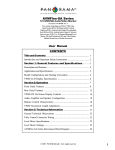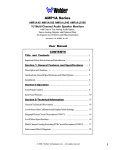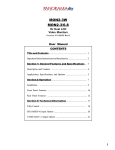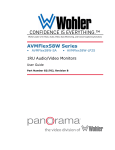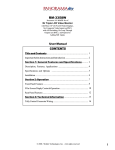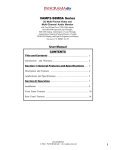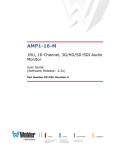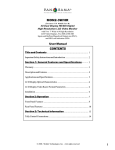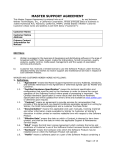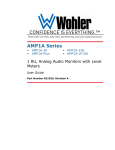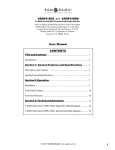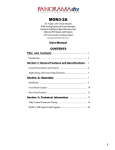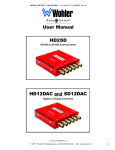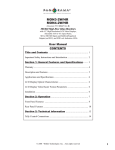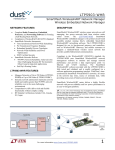Download AVMFlex Series - BroadcastStore.com
Transcript
AVMFlex Series 1U Audio/Video Monitor Two Selectable Stereo Analog Audio Inputs on XLRs, Two Selectable CVBS Video Inputs and Loop-Through Outputs on BNCs, Analog Audio Output of Selected Source on two XLRs, Two 10-Segment Bargraph Level Meters, Phase Indication LED, and Video Display Module Mounted on Flexible Gooseneck Document P/N 821608 Rev. A User Manual CONTENTS Title and Contents ............................................................. 1 Introduction and Installation ...................................................................... 2 Section 1: General Features and Specifications .......... 3 Description and Features .......................................................................... 4 Applications and Specifications ............................................................... 5 Model Configuration and Naming Conventions ......................................... 6 Section 2: Operation ......................................................... 7 Front Panel Features ................................................................................. 8 Rear Panel Features .................................................................................. 12 VPOD-5W On-Screen Display Controls ................................................... 14 Audio Amplifier and Speaker Configuration ............................................. 16 Balance Control Characteristics .............................................................. 16 Section 3: Technical Information ................................... 17 Tally Control Connector Wiring ............................................................... 18 Level Meter Specifications ....................................................................... 19 Level Meter Settings ................................................................................. 19 AVMFlex Series Interconnect Block Diagram .......................................... 20 © 2004 Wohler Technologies Inc. ALL rights reserved 1 Important Safety Instructions 1) Read these instructions. 2) Keep these instructions. 3) Heed all warnings. 4) Follow all instructions. 5) Do not use this apparatus near water. 6) Clean only with dry cloth. 7) Do not block any ventilation openings. Install in accordance with the manufacturer's instructions. 8) Do not install near any heat source such as radiators, heat registers, stoves, or other apparatus (including amplifiers) that produce heat. 9) Do not defeat the safety purpose of the polarized or grounding-type plug. A polarized plug has two blades with one wider than the other. A grounding type plug has two blades and a third grounding prong. The wide blade or the third prong are provided for your safety. If the provided plug does not fit into your outlet, consult an electrician for replacement of the obsolete outlet. 10) Protect the power cord from being walked on or pinched, particularly at plugs convenience receptacles and the point where they exit from the apparatus. 11) Only use attachments/accessories specified by the manufacturer. 12) Use only with the cart stand, tripod, bracket, or table specified by the manufacturer, or sold with the apparatus. When a cart is used, use caution when moving the cart/apparatus combination to avoid injury from tip-over. 13) Unplug this apparatus during lightning storms or when unused for long periods of time. 14) Refer all servicing to qualified service personnel. Servicing is required when the apparatus has been damaged in any way, such as when power-supply cord or plug is damaged, liquid has been spilled or objects have fallen into the apparatus, the apparatus has been exposed to rain or moisture, does not operate normally, or has been dropped. 15) Do not expose this apparatus to rain or moisture. 16) The apparatus shall be connected to a mains socket outlet with a protective earthing connection. CAUTION! In products featuring an audio amplifier and speakers, the surface at the side of the unit, where the audio amplifier heat sink is internally attached, may get very hot after extended operation. When operating the unit excercise caution when touching this surface and ensure that external materials which may be adversely affected by heat are not in contact with it. There is a Hot Surface label (see diagram) attached to the aforementioned surface of the product. Introduction Congratulations on your selection of a PANORAMAdtv product. We are confident it represents the best performance and value available, and we guarantee your satisfaction with it. If you have questions or comments you may contact us at: Wohler Technologies, Inc. 31055 Huntwood Avenue Hayward, CA 94544 Phone: (510) 870-0810 Fax: (510) 870-0811 US Toll-Free: 1-888-596-4537 www.panoramadtv.com 2 [email protected] © 2007 Wohler Technologies, Inc. ALL rights reserved AVMFlex Series User Manual P/N 821608 Rev-A Section 1 General Features and Specifications Description Features Applications Specifications Model Configurations and Naming Convention VPOD Gooseneck Length adjustment Introduction Installation Unpacking Unpack the AVMFlex Series unit from the shipping container and inspect all articles for shipping damage. If you find any damage, notify the shipping carrier immediately for claims adjustments. Compare the shipping box contents to the packing slip. Contact a PANORAMAdtv sales representative if there are any unexplained shortages. Heat Dissipation Heat dissipated by the speaker amps is conducted directly to the left side of the chassis; no special considerations for cooling are necessary as long as the ambient temperature inside the rack area does not exceed approximately 60°C (140°F). Sympathetic Vibration Sympathetic vibration from other equipment (cables, etc.,) in the rack may be serious enough to interfere with the unit’s sound quality out in the listening area. The use of thin card stock and/or felt or foam weather-stripping type materials between adjacent vibrating surfaces, or tying up loose cables, etc., may be required to stop vibrations external to the unit. Audio Connections Connection of the audio feeds is straightforward. Please refer to the system interconnect block diagrams on page 19 for clarification of the general signal paths into and out of the AVMFlex Series units. Rack Mounting The AVMFlex Series unit rack mounts in a standard EIA-310-D specification 19”/483mm rack and needs 1RU of space. Allow sufficient space at the unit rear for connector and cable clearance (approximately 4”/102 mm). The AVMFlex Series unit rack mounts from the front panel support rails. Rear support is not required. Cable Recommendation Recommended cable type for analog video signals is: Belden 8281, Belden 1694A, or equivalent. Recommended cable type for analog audio signals is: Belden 9451 or equivalent. © 2004 PANORAMAdtv ALL rights reserved 3 Section 1: General Features and Specifications AVMFlex Series User Manual P/N 821608 Rev-A AVMFlex Series 1U Audio/Video Monitor AVMFlex4-LP2S Front Panel Description The AVMFlex Series of audio/video monitors provides the capability to monitor CVBS video on a LCD display with full-fidelity stereo audio monitoring in a single rack space (1U). The AVMFlex Series models feature a VPOD LCD video display module mounted to the front panel via a flexible gooseneck allowing for extensive control of the viewing angle. All models in the AVMFlex Series contain four high performance speakers driven by three power amplifiers: two amplifier/driver combinations handle midrange and high frequency information in stereo, while the third center channel reproduces information below the 500 Hz crossover point. Output limiter circuits are incorporated to protect the speakers. The VPOD LCD Video Display is available in 4", 5.6", 5.8" (16:9), 6.8", and 7" (16:9) LCD sizes and features controls for color, tint/hue (NTSC only), contrast, and brightness. The display also has a power LED of its own and a bi-color (red/green) tally indication LED. All AVMFlex Series models come equipped with two 10-segment tri-color (red/amber/green) LED bargraph display level meters, separate volume and balance controls, a power indication LED, headphone output, and a unique LED display, which visually shows phase (polarity) relationships of the signals selected for monitoring. Extensive magnetic shielding allows placement immediately adjacent to video monitors with no color impurities. The AVMFlex Series rear panel is configured with two balanced (stereo) Analog inputs (IN A and IN B) on female XLR connectors and two CVBS video inputs (CVBS A and CVBS B), with loop-through outputs, on female BNC connectors. The audio and video inputs are relayed so that selecting either the A or B video source on the VPOD video display module will also select the associated A or B audio source. Two male XLR connectors are provided to output a balanced Analog audio signal of the selected audio source. A DB-25 connector is also provided for tally connections. Features • Relatively large LCD video display in a space-saving 1U rack size • Bi-amp sum amplification through high/mid and woofer speakers • Choice of 4", 5.6", 5.8" (16:9), 6.8", or 7" (16:9) LCD video display sizes • DB-25 connector on rear panel provided for tally connections • Two selectable analog audio stereo inputs on balanced 3-pin XLR connectors • Flexible gooseneck mounting of video display allows adjustable viewing angle in all directions • Two selectable CVBS video inputs and loop-through outputs on BNC connectors with selectable termination • VPOD LCD video display modules feature: *A/B switch for selection of one of two relayed CVBS video and analog audio inputs *Adjustment for color, tint/hue (NTSC only), contrast, and brightness *Dual color (red/green) talley indication LED *Power indication LED • NTSC/PAL format auto-sensing 4 • Balanced analog ouput of selected audio source on two 3-pin XLR connectors • Two 10-segment tri-color (green/amber/red) LED bargraph display audio level meters • Phase indication LEDs for selected audio source • 98 dB SPL at two feet • Excellent high frequency response for positive detection of background whine and noise • Thorough magnetic shielding for placement next to video monitors • Separate volume and balance controls • Headphone output © 2004 PANORAMAdtv ALL rights reserved Section 1: General Features and Specifications AVMFlex Series User Manual P/N 821608 Rev-A Applications The AVMFlex Series is ideally suited for use in VTR bays, mobile production vehicles, teleconferencing installations, multimedia systems, satellite link and cable TV facilities, and on-air radio studios. Designed and manufactured in the U.S., the AVMFlex Series is backed by a strong warranty and a satisfaction guaranteed return policy. AVMFlex General Specifications 75 Ω (Ohm), selectable Audio Inputs: Analog, x2 Pair 3-Pin XLR-F Video Input Termination: Audio Input Impedance: >40k Ω, balanced Video Output Connectors: 2x BNC (passive loop-through) Audio Outputs: x2 XLR-M balanced (selected source) Video Display Modes: Peak Acoustic Output @2 feet: Frequency Response (1/6 Octave): NTSC/PAL autosensing 98dB SPL Medium-size Segments Video Display Type: (f or Mid dle -distance Vie wingVideo Picture Controls: (for Middle dle-distance -distanceV iewing Power Output: Active Matrix TFT-LCD Brightness, contrast, color, and tint (NTSC only) 80 Hz to 20 Hz (+/- 5 dB) (-10 dB @ 50 Hz, 22 kHz) Video Color Configuration: RGB delta RMS each side = 5W, 7W peak RMS dual woofer = 11W, 16W peak Magnetic Shielding: <1 gauss any adjacent surface Electrical Distortion: <0.15% @ any level below input threshold Power Supply: Internal 100 to 240 VAC, 50-60 Hz Hum and Noise: Better than -68 dB below full output Dimension (h x w x d) (chassis only): 1.75 x 19 x 10 inches 44.5x 483 x 254 mm Video Input Format: CVBS (Composite Analog) video Weight (chassis only): 9.5 lbs. (4.3 kg) w/ 6.8 VPOD Video Input Connectors: 2x BNC inputs VPOD LCD Video Display Specifications VPOD Video Specs: VPOD4 VPOD56 VPOD58W VPOD6 VPOD7W 4" 5.6" 5.8" 6.8" 7" 82.1 x 61.8 113.3 x 84.7 127.2 x 71.84 138.2 x 103.4 154.1 x 88.6 4:3 4:3 16:9 4:3 16:9 480 x 234 960 x 234 1200 x 234 1152 x 234 1440 x 234 Dot Pitch (mm): 0.171 x 0.264 0.118 x 0.362 0.106 x 0.307 0.120 x 0.442 0.107 x 0.370 Contrast Ratio: 150 : 1 150 : 1 150 : 1 150 : 1 150 : 1 250 300 400 300 400 10 / 30 / 45 / 45 10 / 30 / 45 / 45 30 / 60 / 60 / 60 10 / 30 / 45 / 45 60 / 30 / 60 / 60 0.9 lbs. 1 lbs. 1.25 lbs. 1.3 lbs. 1.4 lbs. 3W 7W 7W 8W 10W 3.45 x 4.92 x 1.1 4.15 x 6.4 x 1.22 4.23 x 6.4 x 1.22 5.18 x 7.5 x 1.22 4.93 x 7.4 x 1.22 Screen Size (diagonal inches ): Active Area (H x V, mm): LCD Aspect Ratio: Resolution (dots x lines): Brightness (NITs): Viewing Angle (top/bottom/left/right): Weight (VPOD module w/mount): Power Consumption (Watts, VPOD): Height x Width x Depth (inches): Audio Response 0 dbu ref. 0.775V RMS. Features and specifications subject to improvement without notice. +10 Typical 1/6 Octave Audio Response Curve 0 d B -10 -20 -30 20 50 100 200 500 1k 2k 5k 10k 20k Hz © 2004 PANORAMAdtv ALL rights reserved 5 Section 1: General Features and Specifications AVMFlex Series User Manual P/N 821608 Rev-A Model Configurations and Naming Convention The only difference between the various models of AVMFlex is the size of the LCD video display used in the specified VPOD LCD display module. The chart below lists the model and display sizes. The diagram to the right defines the model naming convention. Model VPOD Model Display Size Two Stereo Channels AVMFlex4-LP2S VPOD4 4" AVMFlex5-LP2S VPOD5 5.6" VPOD5W 5.8" (16x9) AVMFlex6-LP2S VPOD6 6.8" AVMFlex7-LP2S VPOD7 7" (16 x 9) AVMFlex5W-LP2S AVMFlex 5-LP2S Level Meters/Phase Indication VPOD Display Size/Model Audio/Video Monitor VPOD Gooseneck Length Adjustment The VPOD LCD display module may be adjusted for two lengths (1.3" and 2.25") by changing the location of two screws on the bottom of the chassis which are lined up with the VPOD module. To change the length: 1) Locate the adjustment holes on the bottom of the main chassis that correspond with the VPOD module. 2) Remove the two (2) installed screws and set aside for later use. 3) Carefully pull or push the VPOD module until the two holes of the internal gooseneck mount line up with the appropriate two holes in the chassis bottom. Ensure that the LCD display screen is not touched or otherwise damaged during this operation. 4) Reinstall the two screws removed in step 2 into the new position. Front Panel Location "Fixed" Gooseneck length is adjustable by moving a pair of screws on chassis bottom. Position 2 Appox. 1.3" Position 1 Appox. 2.25" Bottom View AVMFlex Series Chassis/Front Panel NOTE: All measurments are from the front panel surface of main chassis to VPOD rear panel surface Figure-3d: VPOD Gooseneck Length Adjustment CAUTION: Do NOT rotate (twist) the VPOD module around the gooseneck axis; the torque may damage the gooseneck and/or internal wiring. Also, avoid touching the LCD video screen itself with the fingers or other objects. 6 © 2004 PANORAMAdtv ALL rights reserved AVMFlex Series User Manual P/N 821608 Rev-A Section 2 Operation Front Panel Features Rear Panel Features VPOD-5W On-Screen Display Controls Audio Amplifier and Speaker Configuration Balance Control Characteristics © 2004 PANORAMAdtv ALL rights reserved 7 AVMFlex Series User Manual P/N 821608 Rev-A Section 2: Operation Front Panel Features Please refer to Figure-2a on the facing page to familiarize yourself with the front panel features of the AVMFlex Series unit. The following sections describe these functions and are referenced, by number, to Figure-2a. 1 Speakers The internal speaker system is comprised of two mid-range tweeter speakers (left and right) and two woofer speakers (left and right). The two mid-range speakers reproduce only the mid and high frequencies, while the two woofer speakers monaurally reproduce the low frequencies. 2 Headphone Output Jack Select the headphone audio sources as you would for the internal speakers. When you plug in headphones, the speakers will mute. This jack accepts a standard 1/4” phone type stereo plug. 3 Phase Indication LEDs These three LEDs offer instant visual verification of phase (polarity) conditions in the pair of channels selected for monitoring in the Left/Right channel speakers. The two smaller top and bottom LEDs, labeled Φ+ and Φ-, show instantaneous phase relationships in the signal, while the larger middle LED, labeled AVG, indicates the average phase condition. The top Φ+ LED glows (or blinks) GREEN when signals are in-phase. The bottom Φ- LED glows (or blinks) AMBER for out-of-phase signals. The middle AVG LED indicates the average phase condition by glowing GREEN for in-phase conditions, or RED for out-of-phase conditions. In general, it is sufficient to regard the AVG LED (average phase condition) as adequate for proper phase monitoring. While it is Φ+ and Φ- small normal for stereo signals to contain some intermittant instantaneous out-of-phase and in-phase conditions (Φ LEDs), a steady red glow of the AVG LED almost always indicates an out-of-phase alarm condition. 4 Audio Level Meters Audio levels are visually displayed via these two 10-segment, tri-color (RED, AMBER, GREEN) LED bargraph display level meters. Bargraph 1 monitors Channel A (left) while Bargraph 2 monitors Channel B (right). These meters are able to display signal levels using either PPM or VU standards as selected via a DIP switch module accessible by removing the top cover of the unit. See page 19 for specifications and settings of these meters. 5 Volume Control This controls the loudness of the audio reproduced by the internal speakers or connected headphone. Clock-wise rotation of this control increases the loudness of the monitored audio in both channels 1 and 2. 6 VPOD LCD Video Display Module Video signals entering the AVMFlex Series unit are monitored through the VPOD LCD video display. The VPOD module is attached to the front panel by a length of flexible gooseneck tubing allowing angle viewing adjustment in all directions. One of five sizes of LCD display screens may be specified, including 4", 5.6", 5.8" (16:9), 6.8", and 7" (16:9) LCD display sizes. See page 10 for complete information on the use and control of the VPOD LCD video display module. 7 Balance Control This pans the volume balance between the left and right speakers. If the balance is adjusted hard left or hard right, a slight left/right channel mix is retained (only in low bass frequencies) so that phase discrepancies can be audibly discerned. 8 © 2004 PANORAMAdtv ALL rights reserved AVMFlex Series User Manual P/N 821608 Rev-A Section 2: Operation Figure-2a: Front Panel Features © 2004 PANORAMAdtv ALL rights reserved 9 AVMFlex Series User Manual P/N 821608 Rev-A Section 2: Operation Front Panel Features Please refer to Figure-2b on the facing page to familiarize yourself with the front panel features of the VPOD LCD display modules that can be specified for the AVMFlex Series units. The following sections describe these features and are referenced, by number, to Figure-2b. The AVMFlex 1U front panel, to which these displays are installed, is described and illustrated on pages 8 and 9. VPOD - LCD Video Display Modules Each VPOD LCD video display module houses the LCD Video Display Screen, Display Controls, A/B Input Select Switch, Tally Indication LED, and Power Indication LED. Each VPOD module is attached to the AVMFlex front panel by a length of flexible gooseneck tubing. AVMFlex Series units are manufactured with a VPOD module permanently attached to the front panel. Five sizes of LCD display screens are available for the AVMFlex Series; 4", 5.6", 5.8" (16:9), 6.8", and 7" (16:9). The VPOD module may be adjusted for viewing angle independant of the fixed position of the main chassis. There is about a +/- 60 degree field of movement of the VPOD module from the vertical and horizontal plane of the front panel. When adjusting the angle of the video screen, grasp the VPOD module at the right/left or top/bottom sides. Care should be taken not to touch the LCD video screen itself with the fingers or other objects. CAUTION: Do NOT rotate (twist) the VPOD module around the gooseneck axis; the torque may damage the gooseneck and/or internal wiring. Also, avoid touching the LCD video screen itself with the fingers or other objects. NOTE: The 5.8" VPOD (VPOD58W), unlike the other VPOD models, features on-screen controls. See page 14 for descriptions of these controls and their use. 1 Tally Indication LED This tri-color LED can glow RED, GREEN, or YELLOW to indicate tally status associated with the video signal displayed. Refer to page 18 for tally connection details. 2 Display Controls The displayed video image for each VPOD LCD display module may be separately adjusted using these four image controls: • TNT = Tint; adjust for desired image color hue (NTSC only). • COL = Color Saturation; adjust for desired amount of image color saturation. • BRT = Brightness; adjust for desired screen brightness. • CNT = Contrast; adjust for desired image scene, dark-to-bright contrast. 3 LCD Video Display Selected video sources are displayed here. Screen image parameters are adjustable by four manual controls (Item 2). See page 5 for LCD display specifications. 4 A/B Input Select Switch This switch selects between the two CVBS video sources (CVBS A and CVBS B) and between the two audio sources (BALANCED IN A and BALANCED IN B). The video and audio inputs are relayed to switch together. The A/B Input Select Switch selects the source signals according to the following switch positions: • Position "A": CVBS IN A video input and BALANCED IN A audio inputs. • Position "B": CVBS IN B video input and BALANCED IN B audio inputs. 5 Power Indication LED This LED glows GREEN to indicate the unit is connected to mains power and an operation voltage is present. 6 VPOD5W On-Screen Display Controls (AVMFlex5W-LP2S Only) Display controls for the 5.8" VPOD (VPOD5W) are set via these three buttons. Parameters are manipulated as described on page 14. 10 © 2004 PANORAMAdtv ALL rights reserved AVMFlex Series User Manual P/N 821608 Rev-A Section 2: Operation Figure-2b: Front Panel Features © 2004 PANORAMAdtv ALL rights reserved 11 AVMFlex Series User Manual P/N 821608 Rev-A Section 2: Operation Rear Panel Features Please refer to Figure-2c on the facing page to familiarize yourself with the rear panel features of the AVMFlex Series units. The following sections describe these features and are referenced, by letter, to Figure-2c. A Power - IEC-320 Connector Attach the supplied standard IEC-320 power cord between this connector and mains power (100 - 250VAC, 50/60 Hz). The front panel Power LED (Item 5, page 10) will glow GREEN to indicate operating voltages are present. B CVBS Video Input and Loop-Through Output Connectors Each of these two female BNC connectors (CVBS A, IN and CVBS B, IN) accept standard CVBS (Composite Analog) video signals and are configured for 75 Ω impedance connections. Note that video input selection is relayed to the audio input selection. See Item 4, page 10 for more information about source selection. Each of the two LOOP output connectors (CVBS A and CVBS B) provide passive signal-through connections from the associated CVBS IN connector to down-stream equipment. See Item C for information about setting the termination for these connectors. Note that these outputs function even if power to the AVMFlex unit is turned OFF. C CVBS Input Temination Select Switch Each switch in this two-section DIP module is used to set the termination characteristics for the CVBS input connector next to it. If a CVBS LOOP connector is connected to downstream equipment, set the appropriate switch to the UP position (UNTERMINATE). If no downstream equipment is connected, then set to the DOWN position (TERMINATE). D Tally Connector This 25 pin sub-miniature female “D” connector allows you to tally the Tally Indication LED (Item 1, page 10). Connection details are described on page 18. E F Audio Stereo Input Connectors (A and B) These female XLR connectors accept standard Analog audio signals and are configured for 40K Ω impedance connections. Left and Right inputs are provided in each of the two input sections (BALANCED IN A and BALANCED IN B). Note that audio input selection is relayed to the video input selection. See Item 4, page 10 for more information about source selection. See the diagram under Item F for pinout information for these connectors. Balanced Audio Output Connectors (Left and Right) These two male 3-pin XLR connectors are analog outputs of the source as selected for the left and right speakers. See the diagram below for pinout information for these connectors. Pin-2 High (+) 12 Pin-1 Gnd (Shield) Pin-1 Gnd (Shield) Pin-2 High (+) Pin-3 Low (-) Pin-3 Low (-) Female XLR Pinout Male XLR Pinout © 2004 PANORAMAdtv ALL rights reserved AVMFlex Series User Manual P/N 821608 Rev-A Section 2: Operation Figure-2c: Rear Panel Features © 2004 PANORAMAdtv ALL rights reserved 13 Section 2: Operation AVMFlex Series User Manual P/N 821608 Rev-A VPOD5W On-Screen Display Controls (AVMFlex5W-LP2S Only) Display controls for the 5.8" VPOD (VPOD5W) are set via the three buttons on the VPOD front panel (See Item 6, page 10). Parameters are manipulated as described below: BRIGHTNESS Press the UP and DOWN buttons directly to increase and decrease the LCD display BRIGHTNESS. The image below will be displayed on-screen while adjusting to indicate the level. BRIGHT COLOR / CONTRAST / TINT 1) Press the MENU button to access the Main Menu onscreen. 2) Press the UP and DOWN buttons to scroll through the options. 3) Press the MENU button to select the chosen parameter for adjustment. 4) Press the UP and DOWN buttons to adjust the level. 5) Press the MENU button to return to the Main Menu. 6) To exit the menu, use the UP and DOWN buttons to select EXIT and then press MENU. NOTE: The TINT parameter is applicable ONLY when monitoring NTSC video source signals. The onscreen menu and pamameters for COLOR, CONTRAST, and TINT controls are shown below: COLOR Adjustment: CONTRAST Adjustment: TINT Adjustment: BRIGHT COLOR CONTRAST TINT [NTSC ONLY] SYSTEM SETUP EXIT COLOR G R B BRIGHT COLOR CONTRAST TINT [NTSC ONLY] SYSTEM SETUP EXIT BRIGHT COLOR CONTRAST TINT [NTSC ONLY] SYSTEM SETUP EXIT (Continued) 14 © 2004 PANORAMAdtv ALL rights reserved CONTRAST TINT Section 2: Operatio AVMFlex Series User Manual P/N 821608 Rev-A VPOD5W On-Screen Display Controls (AVMFlex5W-LP2S Only) (Continued) SYSTEM SETUP To enter the System Setup submenu, choose SYSTEM SETUP in the Main Menu, and press the MENU button. Main Menu: BRIGHT COLOR CONTRAST TINT [NTSC ONLY] SYSTEM SETUP EXIT System Setup Menu: DIMMER 8 POWER SAVING ON FSC SET 3.58MHz TINT [NTSC ONLY] HOR. NOR VER. NOR. MODE NORMAL EXIT Use the UP and DOWN buttons to select System Setup option as shown below. DIMMER 8 1) Press MENU button to select DIMMER 8 option. 2) Press Up and DOWN buttons to select Dimmer level from 0 to 8. 3) Press MENU to activate selection. POWER SAVING ON 1) Press MENU button to select POWER SAVING ON option. 2) Press Up and DOWN buttons to select POWER SAVING ON or POWER SAVING OFF. 3) Press MENU to activate selection. When the display is set up with Power Saving Mode ON, power will automatically turn off after 6 seconds if there is no video signal entering the display. Power will automatically turn as soon as a video signal is detected. FSC SET 3.5MHz 1) Press MENU button to select FSC SET 3.5MHz (Frequency Subcarrier) option. 2) Press Up and DOWN buttons to select FSC SET 3.58MHz or FSC SET 4.43MHz. 3) Press MENU to activate selection. This option will force the Frequency Subcarrier of the display at 3.58MHz or 4.43 MHz. HOR. NOR. 1) Press MENU button to select HOR. NOR. (Horizontal Reverse Image) option. 2) Press Up and DOWN buttons to reverse the image horizontally. 3) Press MENU to activate selection. VER. NOR. 1) Press MENU button to select VER. NOR. (Vertical Reverse Image) option. 2) Press Up and DOWN buttons to reverse the image vertically. 3) Press MENU to activate selection. MODE NORMAL 1) Press MENU button to select MODE NORMAL option. 2) Press Up and DOWN buttons to select NORMAL, ZOOM1, or FULL. 3) Press MENU to activate selection. NORMAL mode will display images in original aspect ratio of source (example: 4:3 ratio displayed undistorted in 16:9 screen with blank space on either side). ZOOM1 mode zooms into center area of display. FULL mode forces aspect ratio of source to conform to 16:9 aspect ratio (example: 4:3 ratio displayed in 16:9 screen stretched [distorted] to fill entire display). EXIT Press MENU button to select EXIT option, press MENU button again to return to Main Menu. © 2004 PANORAMAdtv ALL rights reserved 15 Section 2: Operation AVMFlex Series User Manual P/N 821608 Rev-A Audio Amplifier and Speaker Configuration General Description All AVMFlex Series modals contain high performance transducers (speakers) driven by three power amplifiers; two amplifier/ driver combinations handle midrange and high frequency information in the left and right (stereo) speaker channels, while the third amplifier channel sums the left and right channel information below the 500 Hz crossover point in the woofer (bass) speaker(s). Note that the woofer channel is NOT a dedicated LFE or Center channel. Speaker Configuration The 1U rack size AVMFlex Series products are configured with two speakers (left and right) to reproduce mid- and high-range audio frequencies (in stereo), but feature two woofer speakers to reproduce the summed (combined) low-range audio frequencies from the left and right speaker input channels. It should be noted that both woofer speakers, which are wired in series, are driven from one woofer speaker channel, and are NOT stereo. See the simplified diagram below for a block diagram of the AVMFlex Series audio amplifier/speaker configuration. Left Speaker Input A (Left) EQ Limiter High-Pass Left Speaker Channel Amplifier A Woofer Speaker Volume/ Balance (VCO) Lo-Freq Amplifier Sum Low-Pass Limiter Input B (Right) Woofer Speaker Channel Woofer Speaker Right Speaker EQ Limiter High-Pass Right Speaker Channel Amplifier B AVMFlex Series (1U) Audio Amplifier and Speaker Block Diagram Balance Control Characteristics The balance control attenuates the signal from the source, so that the left and right bass frequencies (summed together and reproduced in the woofer channel) will also respond to the balance control. Example: If an audio signal of a voice speaking English is fed to the "A" (left) input and a voice speaking Spanish is fed to the "B" (right) input, then the left speaker channel will reproduce the mid-range and high-range frequencies of the English speaking voice, the right speaker channel will reproduce the mid-range and high-range frequencies of the Spanish speaking voice, and the woofer speaker channel will reproduce the summed (combined) low-range frequencies of both voices. If the balance control is panned to the left, then the Spanish speaking voice in the right speaker channel will diminish in volume, the Spanish speaking voice in the woofer speaker channel will also diminish, and the English speaking voice in both the right speaker channel and woofer speaker channel will increase slightly (to maintain overall output level). The converse is true if the balance control is panned to the right. See the simplified diagram above for placement of the balance control in the audio amplifier circuit. 16 © 2004 PANORAMAdtv ALL rights reserved AVMFlex Series User Manual P/N 821608 Rev-A Section 3 Technical Information Tally Control Connector Wiring Level Meter Specifications Level Meter Settings AVMFlex Series Interconnect Block Diagram © 2004 PANORAMAdtv ALL rights reserved 17 AVMFlex Series User Manual P/N 821608 Rev-A Tally Control Connector Wiring A front panel dual-color Tally Indication LED (Item 1, page 10) is associated with the VPOD LCD display module. Interface is provided to the LED via the Tally Control Connector (Item D, page 12) located on the rear panel of the main chassis. The Tally Indicator LED is capable of displaying three colors; RED, GREEN, and YELLOW. Illuminating the RED or GREEN LED separately will result in that tally color. Illuminate the RED and GREEN LEDs simultaneously to achieve a YELLOW tally indication in the LED. For Tally Control Connector pinout functions, see Figure-3a below. Two examples of tally connection configurations are shown in Figure-3b, below. You can operate the Tally Indication LED by numerous methods. The two tutorial examples showing isolated and non-isolated activation are illustrated to show basic operation. Although switches are employed in these examples, the LEDs interface with TTL levels. You can design illumination circuits as shown, by using TTL buffers, or by using transistors as switches. Isolated Operating the Tally Indication LED in an isolated configuration requires an external (customer provided) power supply and tally system. If your facility currently has a tally system with companion power source, use this method to integrate the AVMFlex Series tally with your existing tally matrix. NOTE: Ensure the LED power supply provides +5 to +12VDC. Non-Isolated Operating the Tally Indication LED in the non-isolated configuration uses the AVMFlex Series internal power supply to provide the tally LED voltage. Connect your tally closures to the respective AVMFlex tally connections as shown in Figure-3b, below. AVMFlex Series Tally Connector Pin Functions 13 AVMFlex Series Tally Circuit Examples 1 25 390Ω for 12V, None for 5V 14 25 Pin Female Sub-Miniature D Connector PIN # 1 2 3 4 5 6 7 8 9 10 11 12 13 14 15 16 17 18 19 20 21 22 23 24 25 FUNCTION +12VDC (Current Limited) RED Anode GREEN Anode N/C N/C N/C N/C N/C N/C N/C N/C N/C N/C Chassis Ground R/G Common Cathode Chassis Ground Chassis Ground N/C Chassis Ground Chassis Ground N/C Chassis Ground Chassis Ground N/C Chassis Ground Figure-3a 18 220Ω 150Ω ISOLATED (External Power) TALLY CLOSURE CIRCUIT 390Ω 220Ω 150Ω NON-ISOLATED (Internal Power) TALLY CLOSURE CIRCUIT Figure-3b © 2004 PANORAMAdtv ALL rights reserved Section 3: Technical Information AVMFlex Series User Manual P/N 821608 Rev-A Level Meter Specifications Level Calibration: -6, 0, +4, +8 dBv, Selectable Frequency Response: 20 Hz to 18 kHz (±0.5 dB) Level Meter Type: 10-segment LED Bargraph Display LED Colors: Tricolor (red, amber, green) Metering Range: 23 dB Display Mode (Ballistics): VU or PPM, Selectable VU Characteristics: Rise Time = 300 millisecond to 99 % of full indication Decay Time = 300 millisecond PPM Characteristics: Attack Time = 10 milliseconds Decay Time = 2 seconds, 0 to -20 dB Bargraph Length: 2.00" (50.8 mm) LED Segment Size: 0.152" x 0.305" (3.56 x 7.75 mm) LED Segment Pitch: 0.20" (5.08 mm) Segment Brightness, (I f = 20 mA): 5.5 mcd Segment Brightness, Uniformity: <8% difference between segments Adjacent Segment "Off" Brightness: <1% of brightness of active segment Peak Emission Wavelength: green: 570 nm red: 630 nm Level Meter Settings Level Meter DIP Switch Location Two DIP switch modules allow the user to set the level meter parameters independently for each of the two bargraph displays. These DIP switches are accessible by removing the top cover of the unit and are located on two PCBs installed at right angles to the front panel where the level meters are installed. The DIP switches face upwards for easy adjustment. There are four sections (1, 2, 3, 4) on each DIP switch module. The first two sections (1 and 2) are for setting the Meter Input Gain Calibration and the second two sections (3 and 4) are for setting the Bargraph Display Mode. Meter Input Gain Calibration Settings DIP switch sections 1 and 2 set the Meter Input Gain Calibration, which determines the level of the input signal that will result in a "0" reading on the meter bargraphs. The factory setting is +4 dBv, but can instead be set for -6 dBv, 0 dBv, or +8 dBv by the user. See the diagram below for settings. Bargraph Display Modes DIP switch sections 3 and 4 determine how peak levels are displayed (Display Mode) and select either the PPM mode or an autoreset VU Peak mode (NOT the PPM value!). The PPM mode exhibits an attack time of 10 milliseconds and a decay time of 2 seconds from 0 to -20 dB. The VU mode exhibits a 300 millisecond rise to 99% of full indication and a decay of 300 milliseconds. The factory setting is VU mode. See the diagram below for settings. © 2004 PANORAMAdtv ALL rights reserved 19 20 LOOP IN © 2004 PANORAMAdtv ALL rights reserved Balanced Output Balanced Input B Balanced Input A IN LOOP RIGHT LEFT Rear Panel RIGHT LEFT L 3 2 1 0 1 3 5 7 10 20 Left Bargraph Driver PCB 919017L 3 2 1 0 1 3 5 7 10 20 2 R Right Bargraph Driver PCB 919017R Video Display Phase Indication PCB 919084 Headphone Output PCB 910904 Audio Amplifier PCB 919164 Balance Level Meters AVM-Flex Block Diagram R L Volume LED Tally Indication Video In A/B Switch Interconnect Block Diagram Video I/O Switch PCB 910903 Audio I/O Switch PCB 910917 B A LEFT RIGHT B A B A RIGHT LEFT TALLY CVBS B Termination Select CVBS A Rear Panel AVMFlex Series R L AVG 01/14/04 Rev-A Phase Indication Right Woofer Right Speaker Left Speaker Left Woofer VPOD Video Display Module AVMFlex Series User Manual P/N 821608 Rev-A Section 3: Technical Information AVMFlex Series User Manual P/N 821608 Rev-A Notes: © 2004 PANORAMAdtv ALL rights reserved 21 AVMFlex Series User Manual P/N 821608 Rev-A PANORAMAdtv Wohler 711Technologies, Grandview Drive Inc. 31055 Avenue South SanHuntwood Francisco, CA 94080 Hayward, CA 94544 650 589-5676 Fax: 650 589-1355 Phone: web: (510) www.panoramadtv.com 870-0810 Fax: (510) 870-0811 US Toll-Free: 1-888-596-4537 e-mail: [email protected] www.panoramadtv.com [email protected] 22 © 2004 PANORAMAdtv ALL rights reserved






















